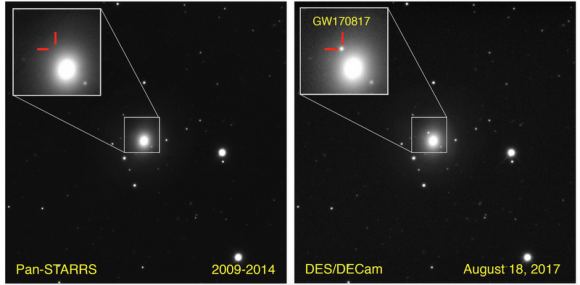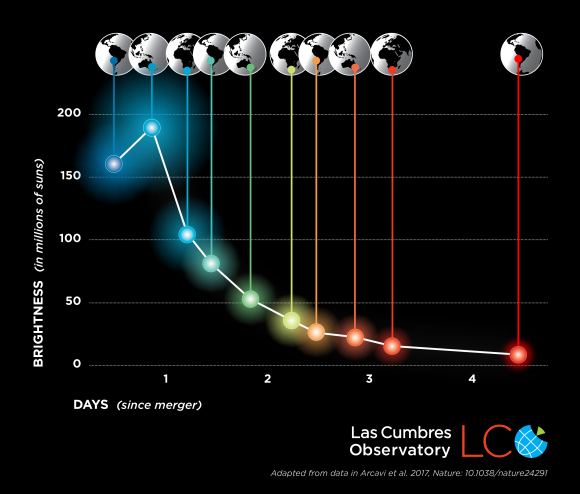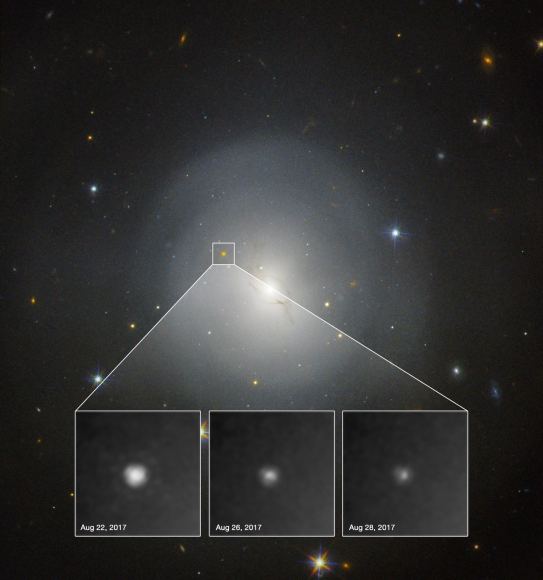About 130 million years ago, in a galaxy far away, two neutron stars collided. The cataclysmic crash produced gravitational waves, ripples in the fabric of space and time. This was now the 5th observation of gravitational waves by the Laser Interferometer Gravitational wave Observatory (LIGO) and Virgo collaboration.
But this event -- called a kilonova -- produced something else too: light, across multiple wavelengths.
For the first time in history, an astronomical phenomenon has been first observed through gravitational waves and then seen with telescopes. In incredibly collaborative effort, over 3,500 astronomers using 100 instruments on over 70 telescopes around the world and in space worked with physicists from the LIGO and Virgo collaboration.
Scientists call this "multimessenger astronomy."
"Together, all these observations are bigger than the sum of their parts," said Laura Cadonati, LIGO's Deputy Spokesperson at a briefing today. "We are now learning about the physics of the universe, in a way that no one has ever done before."

Observations of the kilonova. Credit: P.K. Blanchard/ E. Berger/ Pan-STARRS/DECam.
"It will give us insight into how supernova explosions work, how gold and other heavy elements are created, how the nuclei in our body works and even how fast the universe is expanding," said Manuela Campanelli, from the Rochester Institute of Technology. "Multimessenger astronomy demonstrates how we can combine the old way with the new. It has changed the way astronomy is done."
Neutron stars are the crushed leftover cores of massive stars that long ago exploded as supernovae. The two stars, located near each other in a galaxy called NGC 4993, started out between 8-20 times the mass of our sun. Then with their supernovas, each condensed down to about 10 miles in diameter, the size of a city. These are stars composed entirely of neutrons and are in-between normal stars and black holes in size and density — just a teaspoon of neutron star material would weigh 1 billion tons.
They spun around each other in a cosmic dance until their mutual gravity caused them to collide. That collision produced a fireball of astronomical proportions and the repercussions of that event arrived at Earth 130 million years later.
"While this event took place 130 million years ago, we only found out about this on Earth on August 17, 2017, just before the solar eclipse," said Andy Howell from the Las Cumbres Observatory, speaking at a press briefing today. "We've been keeping this secret the whole time and we're about to bust!"
At 8:41 am EDT, LIGO and Virgo felt the early tremors of the ripples of spacetime, gravitational waves. Just two seconds later, a bright flash of gamma rays was detected by NASA's Fermi space telescope. This allowed researchers to quickly pinpoint the direction from which the waves were coming.
Alerted by an Astronomers Telegram, thousands of astronomers around the world scrambled to make observations and begin collecting additional data from the neutron star merger.
"This event has the most precise sky localization of all detected gravitational waves so far," Jo van den Brand, spokesperson for the Virgo collaboration, said in a statement. "This record precision enabled astronomers to perform follow-up observations that led to a plethora of breathtaking results."
This provides the first real evidence that light and gravitational waves travel at the same speeds – near the speed of light -- as Einstein predicted.

The kilonova became red and faded by a factor of over 20 in just a few days. This rapid change was captured by Las Cumbres Observatory telescopes as night time moved around the globe. Credit: Sarah Wilkinson / LCO.
Observatories from the very small to the most well-known were involved, quickly making observations. While bright at first, the event faded in less than 6 days.
Hubble captured images of the galaxy in visible and infrared light, witnessing a new bright object within NGC 4993 that was brighter than a nova but fainter than a supernova. The images showed that the object faded noticeably over the six days of the Hubble observations. Using Hubble's spectroscopic capabilities the teams also found indications of material being ejected by the kilonova as fast as one-fifth of the speed of light.

On 17 August 2017, the Laser Interferometer Gravitational-Wave Observatory (LIGO) and the Virgo Interferometer both detected gravitational waves from the collision between two neutron stars. Within 12 hours observatories had identified the source of the event within the lenticular galaxy NGC 4993, shown in this image gathered with the NASA/ESA Hubble Space Telescope. The associated stellar flare, a kilonova, is clearly visible in the Hubble observations. This is the first time the optical counterpart of a gravitational wave event was observed. Hubble observed the kilonova gradually fading over the course of six days, as shown in these observations taken in between 22 and 28 August (insets). Credit: NASA and ESA. Acknowledgment: A.J. Levan (U. Warwick), N.R. Tanvir (U. Leicester), and A. Fruchter and O. Fox (STScI).
"This is a game-changer for astrophysics," said Howell. "A hundred years after Einstein theorized gravitational waves, we've seen them and traced them back to their source to find an explosion with new physics of the kind we only dreamed about before."
Here are just a few of insights this single event created, using multimessenger astronomy:
* Gamma rays: These flashes of light are now definitively associated with merging neutron stars and will help scientists figure out how supernova explosions work, explained Richard O'Shaughnessy, also from Rochester Institute of Technology and a member of the LIGO team. "The initial gamma-ray measurements, combined with the gravitational-wave detection, further confirm Einstein's general theory of relativity, which predicts that gravitational waves should travel at the speed of light," he said.
* The source of gold and platinum: "These observations reveal the direct fingerprints of the heaviest elements in the periodic table," said Edo Berger, from the Harvard Smithsonian Center for Astrophysics, speaking at the briefing. "The collision of the two neutron stars produced 10 times of mass of Earth in gold and platinum alone. Think about how as these materials are flying out of this event, it eventually combined with other elements to form stars, planets, life… and jewelry."
Berger added something to think about: the original supernova explosions of these stars produced all the heavy elements up to iron and nickel. Then in the kilonova in this one system, we can see the complete history of how the periodocial table of the heavy elements came to being.
* Nuclear physics astronomy: "Eventually, more observations like this discovery will tell us how the nuclei in our body works," O'Shaughnessy said. "The effects of gravity on neutron stars will tell us how big balls of neutrons behave, and, by inference, little balls of neutrons and protons -- the stuff inside of our body that makes up most of our mass"; and
* Cosmology:- "Scientists now can independently measure how fast the universe is expanding by comparing the distance to the galaxy containing the bright flare of light and distance inferred from our gravitational wave observation," said O'Shaughnessy.
"The ability to study the same event with both gravitational waves and light is a real revolution in astronomy," said astronomer Tony Piro from the CfA. "We can now study the universe with completely different probes, which teaches things we could never know with only one or the other."
No comments:
Post a Comment